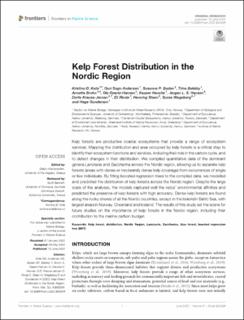| dc.contributor.author | Kvile, Kristina Øie | |
| dc.contributor.author | Andersen, Guri Sogn | |
| dc.contributor.author | Baden, Susanne | |
| dc.contributor.author | Bekkby, Trine | |
| dc.contributor.author | Bruhn, Annette | |
| dc.contributor.author | Geertz-Hansen, Ole | |
| dc.contributor.author | Hancke, Kasper | |
| dc.contributor.author | Hansen, Jørgen L.S. | |
| dc.contributor.author | Krause-Jensen, Dorte | |
| dc.contributor.author | Rinde, Eli | |
| dc.contributor.author | Steen, Henning | |
| dc.contributor.author | Wegeberg, Susse | |
| dc.contributor.author | Gundersen, Hege | |
| dc.date.accessioned | 2022-09-09T14:21:57Z | |
| dc.date.available | 2022-09-09T14:21:57Z | |
| dc.date.created | 2022-08-01T15:12:06Z | |
| dc.date.issued | 2022 | |
| dc.identifier.citation | Frontiers in Marine Science. 2022, 9, 850359. | en_US |
| dc.identifier.issn | 2296-7745 | |
| dc.identifier.uri | https://hdl.handle.net/11250/3016941 | |
| dc.description.abstract | Kelp forests are productive coastal ecosystems that provide a range of ecosystem services. Mapping the distribution and area occupied by kelp forests is a critical step to identify their ecosystem functions and services, including their role in the carbon cycle, and to detect changes in their distribution. We compiled quantitative data of the dominant genera Laminaria and Saccharina across the Nordic region, allowing us to separate kelp forests (areas with dense or moderately dense kelp coverage) from occurrences of single or few individuals. By fitting boosted regression trees to the compiled data, we modelled and predicted the distribution of kelp forests across the Nordic region. Despite the large scale of the analyses, the models captured well the kelps’ environmental affinities and predicted the presence of kelp forests with high accuracy. Dense kelp forests are found along the rocky shores of all the Nordic countries, except in the brackish Baltic Sea, with largest areas in Norway, Greenland and Iceland. The results of this study set the scene for future studies on the importance of kelp forests in the Nordic region, including their contribution to the marine carbon budget. | en_US |
| dc.language.iso | eng | en_US |
| dc.publisher | Frontiers | en_US |
| dc.relation.uri | https://www.frontiersin.org/articles/10.3389/fmars.2022.850359/full | |
| dc.rights | Navngivelse 4.0 Internasjonal | * |
| dc.rights.uri | http://creativecommons.org/licenses/by/4.0/deed.no | * |
| dc.title | Kelp forest distribution in the Nordic region | en_US |
| dc.type | Peer reviewed | en_US |
| dc.type | Journal article | en_US |
| dc.description.version | publishedVersion | en_US |
| dc.rights.holder | Copyright © 2022 Kvile, Andersen, Baden, Bekkby, Bruhn, Geertz-Hansen, Hancke, Hansen, Krause-Jensen, Rinde, Steen, Wegeberg and Gundersen. | en_US |
| dc.source.pagenumber | 13 | en_US |
| dc.source.volume | 9 | en_US |
| dc.source.journal | Frontiers in Marine Science | en_US |
| dc.identifier.doi | 10.3389/fmars.2022.850359 | |
| dc.identifier.cristin | 2040423 | |
| dc.relation.project | EC/H2020/869154 | en_US |
| dc.relation.project | Norges forskningsråd: 280732 | en_US |
| dc.relation.project | Miljødirektoratet: 17080044 | en_US |
| dc.source.articlenumber | 850359 | en_US |
| cristin.ispublished | true | |
| cristin.fulltext | original | |
| cristin.qualitycode | 1 | |

